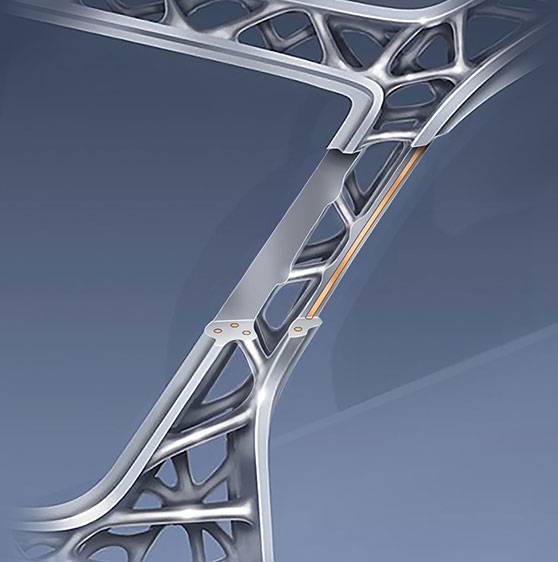Metal Additive Manufacturing (AM) technologies versatility makes them most suitable for producing from unique parts up to full series production. Yet, even the mostly used Metal AM (MAM) technology, Powder Bed Fusion (PBF), is not capable of going beyond single materials, and even the range of standard alloys is rather small. The MULTI-FUN project aims to address those shortcomings in two ways. First, by improving performance and efficiency in metal additive manufacturing through the integration of multi-functionalities based on novel active materials and the development of new structural materials for Wire Arc Additive Manufacturing (WAAM), including high strength aluminium alloys and low alloyed steel grades. And secondly by enabling multi-material design in geometrically complex 3D parts without being hindered by size. The project focuses on Metal Additive Manufacturing by applying combinations of different materials, combined with the most appropriate AM technology for the deposition, to maximize the benefits. Wire and powder based directed energy deposition (DED) and material jetting are employed in new AM equipment combining different AM technologies with tailored software. The inclusion of nano-materials allows the integration of novel and breakthrough features, such as heat sink materials with the highest thermal conductivity, a high degree of integral design that makes it possible to embed electrical conductors in complex shaped metal structures, and the addition of sensing and data transfer capabilities to the equipment and software development. In addition, the integration of tailored optical fibres will enable bringing advanced thorough sensing capabilities to the manufactured parts to perform Structural Health Monitoring (SHM).
An ambitious project to broaden the scope of usage for metal additive manufacturing
The project has a total of four science and technology objectives. The first objective pertains to the development of five new materials customized for additive manufacturing, with a minimum of three of them using nanotechnology. This will allow for the creation of new products by maximizing thermal conductivity, minimizing electrical conductivity and/or improving wear resistance of metals. As a result of this objective, the development of new products is expected thanks to the advanced structural metals and corresponding active material solutions for innovative multiple functionalities. The second addresses new processes and it entails the development of Additive Manufacturing equipment and software to produce the requested material compositions during the layer build-up. In total, at least 10 new material combinations applying 5 new materials will be shown by the 7 demonstrators for different applications. The expected result is an innovative additive manufacturing equipment that integrates several additive manufacturing technologies working in parallel.
The third science and technology objective aims to manufacture and evaluate 7 physical demonstrators with multi-material design and integrated multi-functionalities, for 3 use cases (structural parts, molds, test equipment), addressing 4 different markets (automotive, aviation, space and production industry). The expected end result is related to new methods and it will contribute to the development of new knowledge on increased efficiency of parts & molds due to integrated, multi-material-based functions. The last objective relates to the constant assessment and improvement through a feedback loop of the reduction of environmental and economic impact, by evaluating additive manufacturing materials, hardware, process strategy and demonstrator design. The expected key result from this objective relates to new standards and it will enhance knowledge and contribute to standards and support regulatory bodies adapting to multi- material additive manufacturing.
MULTI-FUN Demonstrators
The expected impact will be felt mani-fold. The defined KPIs fall into three main groups, including:
- First, the improvement of the efficiency, quality and reliability of the product by at least 40%;
- Secondly a better usage of raw materials and resources with reduced environmental impact and lowering costs by 35% as demonstrated by Life Cycle Assessment; and
- Lastly, it will provide new opportunities & business for SMEs across Europe, namely for the key players in advanced materials research in Additive Manufacturing.
Project Partners
This three-year project brings together a total of twenty-one partners from eight countries – Austria, Switzerland, Germany, Spain, United Kingdom, Poland, Portugal and Belgium. sets a clear focus on market- creating innovation, developing advanced materials and equipment for Additive Manufacturing of multi- material parts. Leading experts in AM process & equipment manufacturing (from SMEs, IND, RTOs and UNIV) will fully cover the physical integration of these advanced materials into metallic substrates.
Consortium members include:
Austria: LKR Leichtmetallkompetenzzentrum Ranshofen GmbH | voestalpine Metal Forming GmbH ; Inocon Technologie GmbH | RHP Technology GmbH ; Peak Technology GmbH | Alpex Technologies GmbH | AVL List GmbH | RUAG Space GmbH
Belgium: European Federation for Welding, Joining and Cutting
Germany: Deutsches Zentrum Fuer Luft – Und Raumfahrt EV, Institute of Materials Research | Fraunhofer | MIGAL.CO GmbH | EDAG Engineering GmbH
Poland: INPHOTECH SP ZOO
Portugal: Instituto de Soldadura e Qualidade – ISQ
Spain: Basque Centre for Materials, Applications and Nanostructures | LORTEK S COOP | Aerotecnic Metallic SL
Switzerland: Aluwag AG
United Kingdom: Cranfield University | WAAM3D Limited



